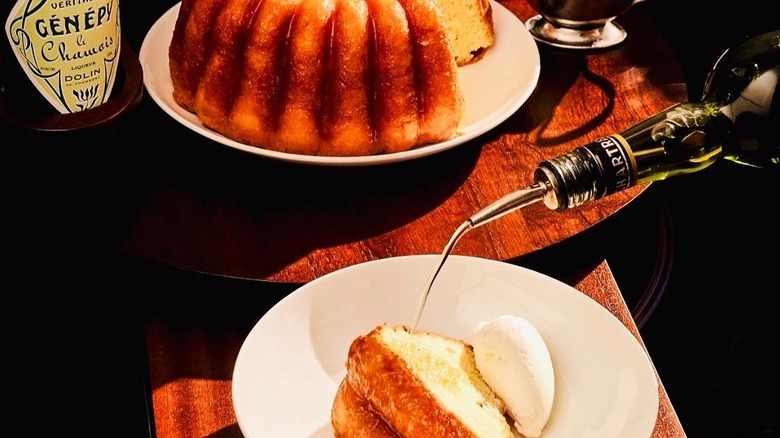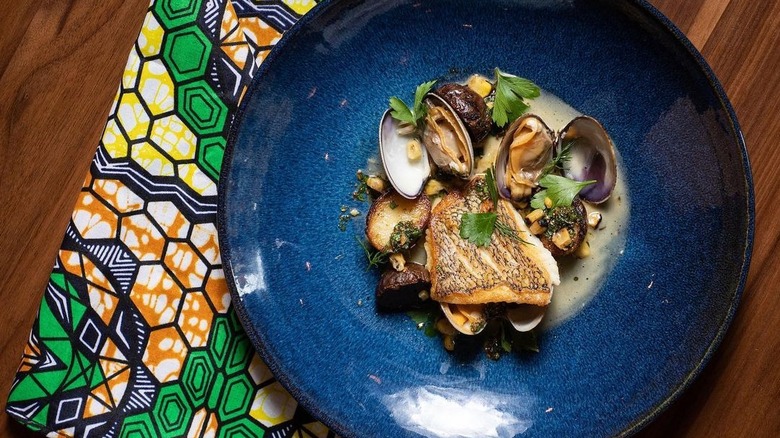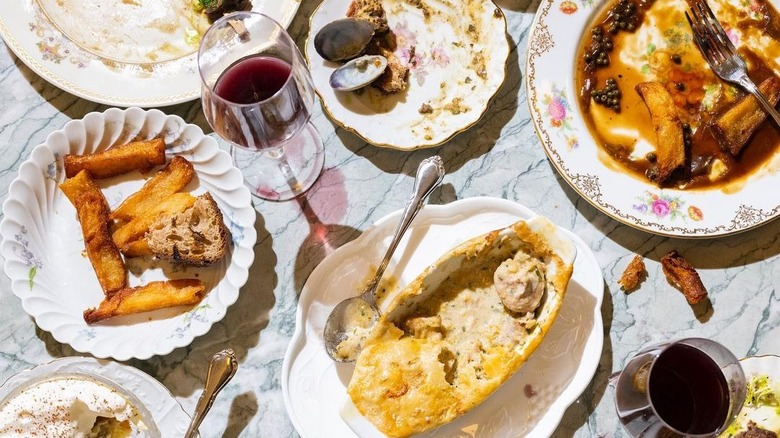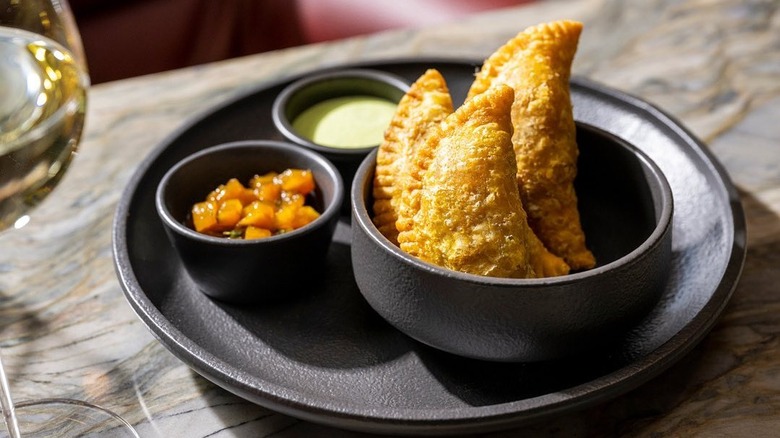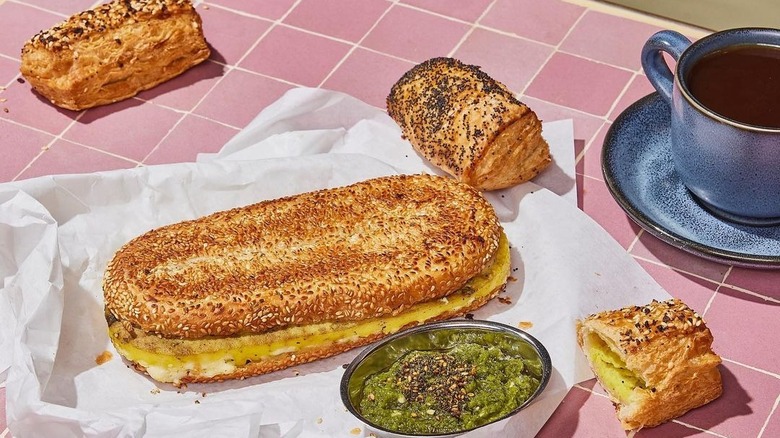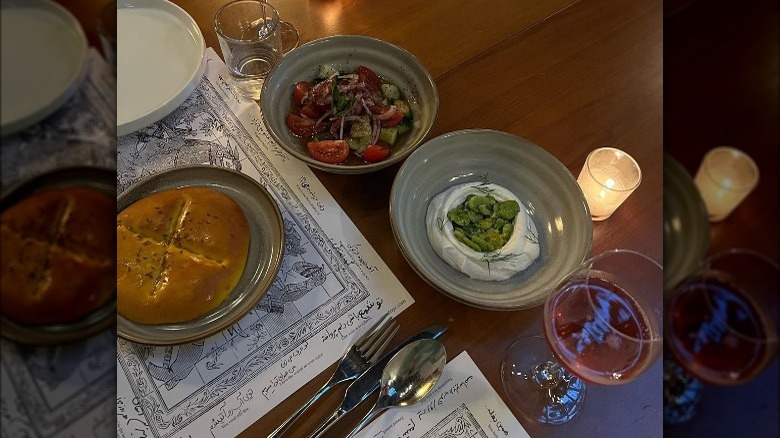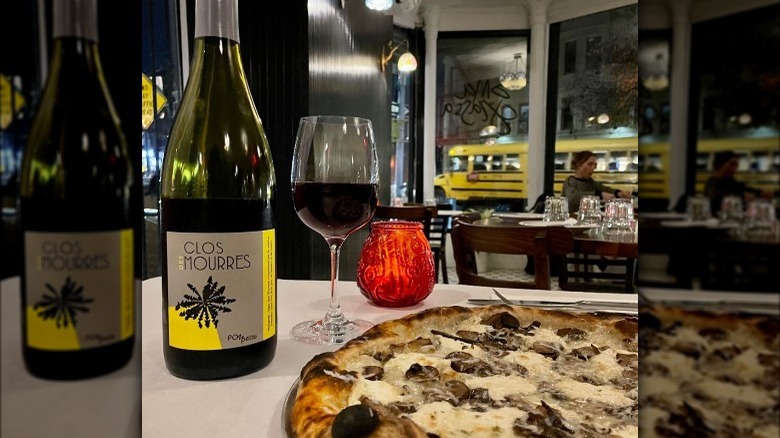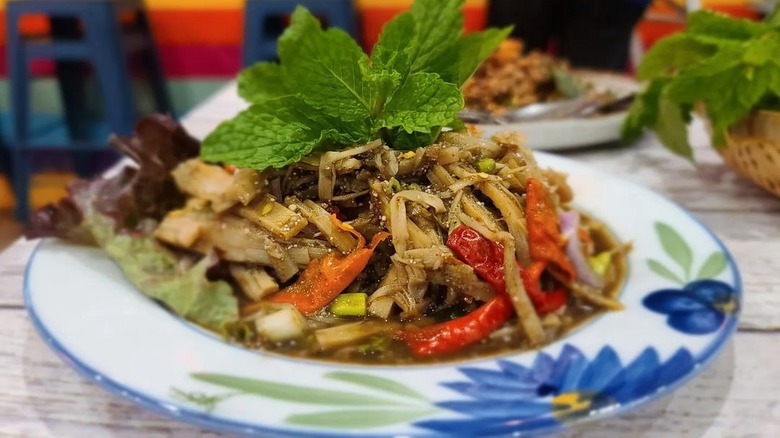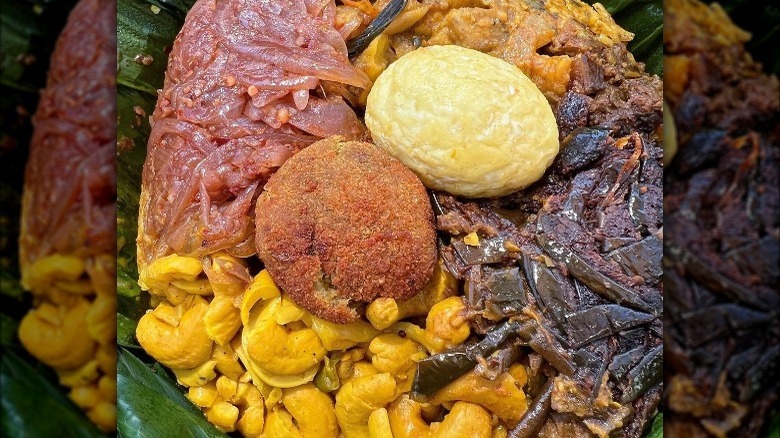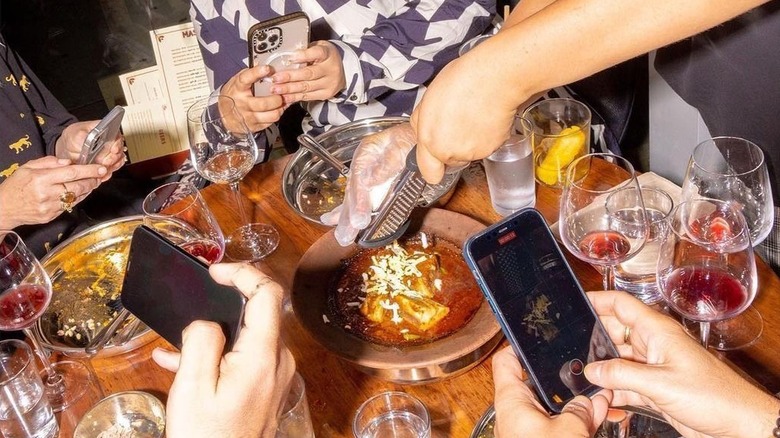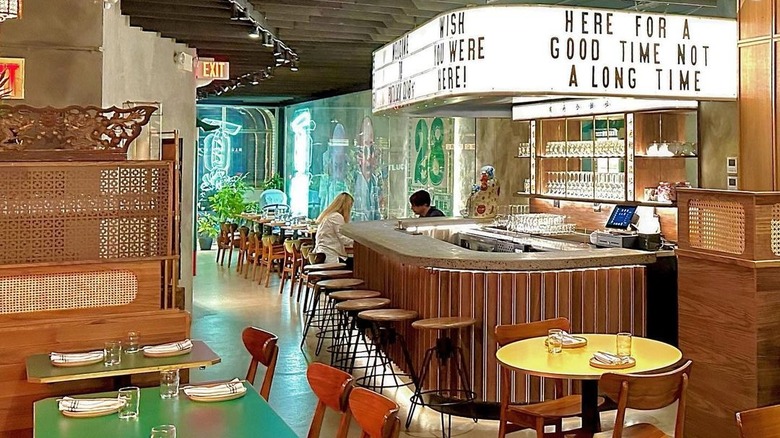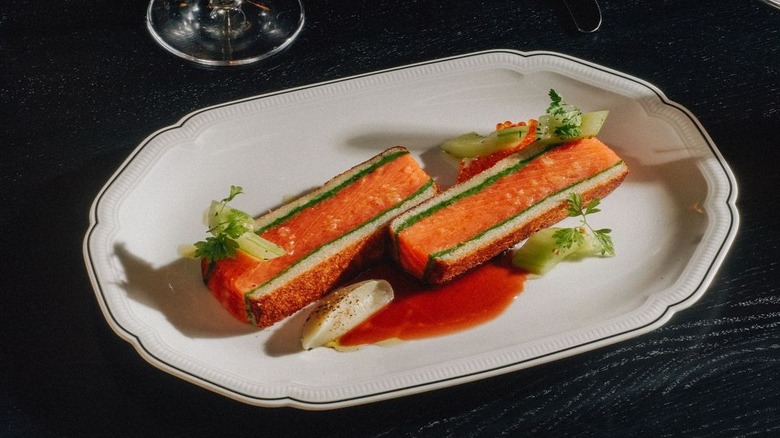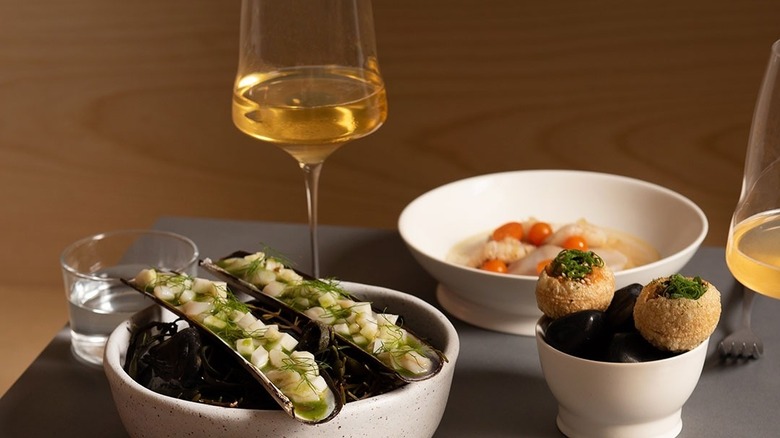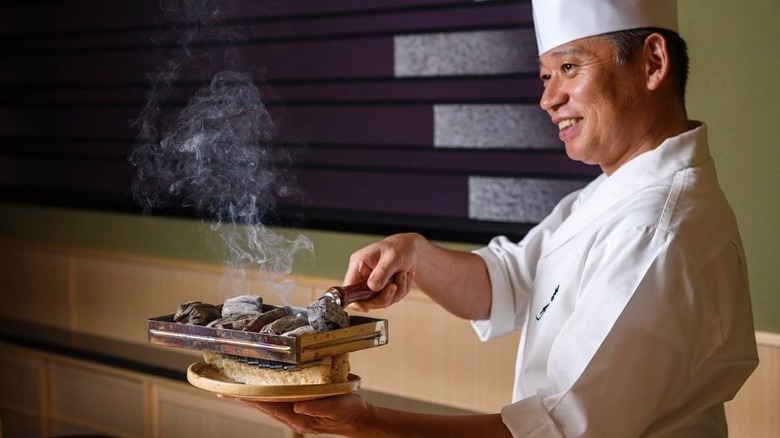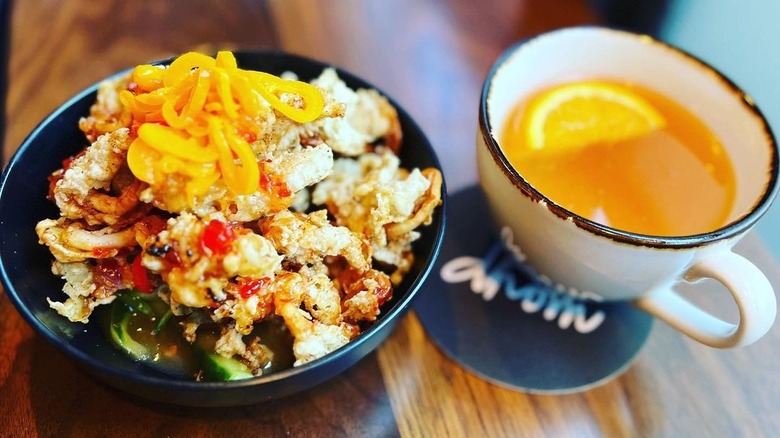The 15 Best New Restaurants In NYC 2022
It's the most wonderful time of year! No, we're not talking about kids jingle belling and everyone telling you to be of good cheer. It's "Best of the Year" season and we're getting in on the action with our best new restaurants in New York City for 2022.
While there's still a bit of uncertainty around COVID-19, 2022 will likely be remembered as the year NYC residents began re-engaging with the town's world-class dining scene. This past year saw a lot to get excited about, from restaurants at a new-look Rockefeller Center to winning concepts forged in the crucible of COVID pandemic.
Of course, this story isn't all about the past two years' events. The ongoing, long-term demographic shift in Chinatown inspired the new restaurant Potluck Club and its modern Asian-American concept. In Park Slope, the owners of Masalawala & Sons are finally serving the regional Indian food they've always wanted to sell, after a decade of slinging Americanized food in the Lower East Side.
With holiday songs or your favorite "Best of" Spotify playlist in the background, consider the following best new spots to eat and drink in NYC.
Le Rock
For many years, Rockefeller Center lured in tourists with megabrands like Lego, Tiffany, Kate Spade, and Michael Kors. But in post-COVID New York, the iconic complex has pivoted to embracing more independent — dare we say hipper — brands as a way to attract more native New Yorkers.
Opened by two chefs from the highly-acclaimed Frenchette in Tribeca, Le Rock is a prime example of this new-look Rockefeller Center. Like its surroundings, Le Rock is making old new again by focusing on classic French bistro cuisine. The notion of fine dining has been in such decline that many new French restaurants feel the need to position themselves in post-modern or ironic ways. Le Rock doesn't do this. It unapologetically goes hard at all things French brasserie. In an era when pop food culture is filled with people mashing up well-known dishes, it's kind of refreshing. "I guess I want to get away from 'this is our spin,' or 'take,' or 'twist' on a dish," co-owner Riad Nasr told Resy.
And so it makes sense that almost all of the menu is written in French. Expect classics like escargot bourguignons, poulet rotie espelette, and other dishes you probably haven't heard mentioned since Julia Child graced American airwaves. But is Le Rock too fancy, too French to succeed around the corner from The Lego Store? Nasr doesn't believe so. "(Guests are) the ones that are pushing the industry, and pushing chefs to be more inventive," he told Resy. "So let's give them a lot more credit, rather than dumb things down."
Hav & Mar
At Hav & Mar in Chelsea, celebrity chef Marcus Samuelsson aims to both celebrate his own unique background and the greater diversity of the African diaspora. The New Yorker of Swedish and Ethiopian heritage puts himself on a plate with dishes like Swediopian ($21), a cured salmon dish, and Addis York, doro wat with a soft-boiled egg and cheese. But to his credit, Samuelson isn't making Hav & Mar all about his food. "This is a place where Black excellence is going to be celebrated outside Harlem, so our goal is to work with Black and BIPOC winemakers and farmers," he told Vogue.
Some of the most prominent positions at Samuelsson's new NYC restaurant are staffed by women of color, including executive chef Rose Noël and head baker Farheen Jafarey. Artist Derrick Adams devised a black mermaid design motif inspired by the restaurant's focus on seafood and soul food.
Hav & Mar — which comes from the Swedish word for sea ("hav") and the Amharic word for honey ("mar") — is another crown jewel in Samuelsson's growing restaurant empire. In addition to Red Rooster located in Harlem, which put his name on the map, the celebrity chef also owns more than a dozen restaurants throughout Scandinavia.
Lord's
After walking into Lord's in NoHo on a typical night, you're being enveloped by fussed-over English décor, tucking into decadent Oysters Kilpatrick, and swooning to the sounds of Ray Charles. Partners Patricia Howard and Ed Symanski have a head-turning hit with Lord's, but today's brilliant success is a long way from the dark nadir of their pandemic.
In early 2020, Howard and Symanski were courting investors for an upscale, meat-focused English dining concept called Dame when COVID-19 struck an existential blow to the very idea of dining out. Like a football club dropping out of the English Premier League, the partners' visions of grandeur were suddenly relegated to pipe dreams. But they found renewed inspiration when the Black Lives Matter movement exploded in the summer of 2020: Dame was relaunched as a seafood pop-up that sent proceeds to the movement. Good intentions aside, the pop-up became a bona fide hit for its fish and chips, culminating in a profile in The New Yorker. In June 2021, Dame opened as a brick-and-mortar restaurant that continued to build on the success of the pop-up.
Lord's is based on that initial vision for Dame. Steeped in English culinary tradition, the London-born Symanski celebrates entire animals with nose-to-tail butchery and cooking. But the menu is also informed by Dame's transition. In a culmination of the partners' journey, dishes like hay-smoked trout and poached skate feature prominently. "It's so weird to me that we've become known for seafood cooking," Symanski told Eater.
Tatiana by Kwame Onwuachi
Less than 10 miles but a world away from where he grew up in the Bronx, Kwame Onwuachi recently opened Tatiana, his first restaurant, at Lincoln Center. The "Top Chef" alum brought his personal heritage and experience to bear in a restaurant that is equal parts stardust and salt-of-the-earth. With the Michelin-pedigreed Al Coro and Cote as its architectural design team, Tatiana dazzles the retinas with iridescent tiles, gold-chain curtains, and color-changing artificial clouds — inspired by asphalt oil slicks, chain-link fences, and Onwuachi's love of dreams respectively.
The modern food at Tatiana is similarly inspired by Onwuachi's experiences and it reads a bit like greatest hits from "Top Chef": truffle "chopped cheese" bao buns, honeynut squash piri piri salad, and a glazed honeybun with powdered donut ice cream. But the showstopper dish is the short-rib pastrami suya. Brined, spiced rubbed, and slow roasted, Onwuachi's Africa-inspired take on pastrami is said to rival the classic version at the iconic Katz's Delicatessen. If you've ever had the pastrami at Katz's, you know that's high praise indeed.
K'Far
Specializing in Jerusalem-via-Philly café fare, K'Far is a premier example of a curious 21st-century phenomenon — the hotel restaurant that's a destination for locals. Walk into the all-day café at The Hoxton Hotel in Williamsburg, and you're just as likely to see tourists as you are to see people from the surrounding neighborhood. It's a testament to the café's name, which means "village" in Hebrew.
When it comes to the lunch and dinner menus at K'Far, pastry chef Katreena Kanney is the star of the show. Try reading the following menu items without involuntarily salivating: pistachio sticky buns, apple babkas, and Tunisian salads with seared tuna, preserved lemon, olives, and harissa. After lunch, K'Far gets livelier. Lights are dimmed. Music turns up. Pricier dinner menus get rolled out. Servers clad in black briskly walk from table to table (via Brooklyn Magazine). It's a necessary and welcome reminder that every village needs to let loose after the day's work is done.
Eyval
Speaking about his successful restaurant Eyval, chef Ali Saboor told Bushwick Daily that Persian cooking is based on using a "beautiful pantry" that includes items like Omani limes, fenugreek, and a fermented dairy product called kashk. At Eyval, Saboor uses his Persian pantry and influence from across the Middle East to give New Yorkers well-executed dishes from Central Asia: "We want you to go through all these flavor profiles from the north of Iran, from the south of Iran and from my take on things — my vision of Persian food."
In addition to featuring Persian cuisine, Eyval is notable for its use of live-fire cooking. On a recent trip to Iran, Saboor was inspired by street food stands offering skewers of meat and organs roasted over charcoal. His subsequent menu at Eyval is perfumed with smoke and flavored with char. Lamb ribs are prepared with a tamarind-date glaze, walnuts, and barberries. Duck breast is served a pomegranate-walnut sauce and basmati rice. Charred shrimp are served with saffron butter. These dishes are informed by Persian food, but Saboor notes to Bushwick Daily that he has greater access to ingredients compared to cooks in Iran: "When it comes to food, they haven't had the same chances and bounty that lets us try new things and push new things."
Oma Grassa
Conceived in coal and gestated in natural gas, New York-style pizza was born out of the fiery hot furnaces of the 19th and 20th centuries. But like Bob Dylan before him, pizzaiolo Adam Baumgart has gone electric at his Fort Greene pizzeria Oma Grassa.
The electric pizza ovens at Oma Grassa are set to 650 degrees F — a cooking temperature that splits the difference between that of a gas-fired pizza oven and a coal-fired oven (via Eater). The hot stone floor of these ovens makes for a pie that is much crispier than a New York-style pizza. This structure allows these pizzas to stand up better to generous amounts of toppings, and Baumgart isn't shy when it comes to decorating his pies with ingredients like fennel sausage, pickled chilies, pepperoni, and mushrooms. One menu highlight is a tomato pie topped with anchovies, capers, olives, and a few whiskers of pecorino cheese.
Baumgart told Brooklyn Magazine that he partly has the pandemic to thank for the opening of Oma Grassa, particularly Governor Cuomo's much-derided food mandate. "During the early pandemic, I started a pizza pop-up in my friend's bar, Botanica, on Houston Street. Because of Cuomo's mandate, he needed food in the bar ... we bought a nice oven, put it in the basement, and got this whole thing started."
Zaab Zaab
If you open a Thai restaurant in a place referred to as Thai Town, you had better bring the goods. Zaab Zaab does just that by serving kaleidoscopic dishes from Northern Thailand's Isan region. Typically featuring sticky rice, fresh produce, chilis, cilantro, mint, and various aromatics — Isan food is wildly popular all over Thailand. It started appearing on the menus of New York's Thai restaurants in the 90s, and today, you can find a number of restaurants that exclusively serve Isan food. Zaab Zaab has been serving up a number of Isan dishes to rave reviews. Some of the most popular menu items include a salt-crusted roasted whole tilapia (Mieng Pla Pow) and pork belly with bamboo shoots wrapped in banana leaves (Hor Mok). Zaab Zaab also distinguishes itself with its use of offal, including blood, liver meat, and chicken gizzards.
Zaab Zaab is another restaurant that may not have existed if it weren't for the pandemic. Co-owners Pei Wei and Bryan Chunton had to shut down their Haianese chicken restaurant Eat Gai due to the omicron variant, and during the shutdown, they were wowed by a staff meal of Isan food from one of their sauté cooks, Aniwat Khotsopa (via Gothamist). They were so blown away, in fact, that the co-owners switched Eat Gai to an Isan concept and made Khotsopa the top chef.
Queens Lanka
On the outside, Queens Lanka looks like one of New York city's countless corner delis, but inside chef and co-owner Rasika Wetthasinghe flexes classical training and a Sri Lankan heritage to create a menu of dazzling Sri Lankan dishes. For example, a humbly-described dish of "rice and curry" at Queens Lanka might contain four kinds of curry, beetroot batons, deep-fried sprats, and a traditional relish called gotu kola sambol. Another menu highlight, lamprais, is a rice dish wrapped in a banana leaf and prepared with curried cashews, pickled fried eggplant, and curried mackerel-potato fritter.
Like the deceptively humble storefront, the story behind Queens Lanka goes much deeper than a formally trained chef serving up highly-complex Sri Lankan classics. Wetthasinghe and his co-owner Suchira Wijayarathne both have wives and children back in their native Sri Lanka (via The New Yorker). The high-profile success of Queens Lanka would suggest that the co-owners are better able to financially support their families, who are living in a country recently rocked by political strife and facing seismic uncertainty.
Masalawala & Sons
For years, Park Slope residents didn't have a buzzy restaurant to call their own. But with the opening of Masalawala & Sons, residents in the Brooklyn neighborhood got what they were asking for, and then some. In December, the New York Post called Masalawala the toughest reservation in New York City, with a waitlist of more than 600 people long for the 36-seat restaurant. From staking out the restaurant before it opens to using American Express dining concierge benefits, customers have been going to great lengths to land seats at one of Masalawala's coveted tables.
A quick scan of the food being served at Masalawala should tell you why the restaurant is in such demand: fresh coconut flesh carved tableside into shrimp curry, bone marrow and paya curry sauce, and fish roll over rice with egg yolk, ghee, and green chilis. Those dishes are a far cry from what was being served at the original Masalawala, which was located in the Lower East Side from 2011 to 2021. The original incarnation ended up focusing on Americanized classics like chicken tikka masala and spicy vindaloo. With the new Park Slope location, James Beard award-winning chef Chintan Pandya is cooking dishes inspired by memories and personal experiences with food from different regions around India (via Grub Street). In the process, he's creating memories for his guests — once they're able to get in the door, that is.
Potluck Club
We like to think of ethnic neighborhoods like New York City's Chinatown as everlasting. But there was a time when Chinatown wasn't Chinatown. And there will be a time when the neighborhood is as Chinese as any other in the city. Thanks to gentrification and generational shifts, the Chinese families that made Chinatown what it is are increasingly moving away. A message on the theater-like marquee in Chinatown's new Potluck Club acknowledges this inherently transient nature of the surrounding neighborhood: Here for a good time, not a long time.
Potluck Club is essentially a love letter to Chinatown, the Cantonese American culture that gave the neighborhood its identity, and a broader sense of New York's Asian cultures. Speaking with Resy about the inspiration behind Potluck Club, co-owner Cory Ng said his Asian American ownership group "grew up here, and not in Asia ... (W)e wanted our restaurant to reflect this: heavily Asian rooted, but not just within the confines of being Chinese."
Some dishes at Potluck Club are what you might expect: modern reboots of American Chinese classics like salt-and-pepper chicken with Southern-style scallion biscuits. But some dishes are more modern and chef-driven. An endive salad is made with dragonfruit, cara cara organs, pistachios, and pecorino cheese. A tiger shrimp main dish is prepared with Calabrian chili aioli, hot honey, candied walnuts, and a broccoli-cauliflower hybrid called caulilini. It all sounds like a good time, as promised.
Koloman
Just as the décor in the new NoMad restaurant Koloman was made lighter and brighter compared to the former tenant Breslin, the restaurant's food is a stripped-down version of two Western European cuisines: French and Viennese. After collecting a Michelin star with modern French cooking at Bâtard, chef-owner and Austria native Markus Glocker is bringing more of his personal history to Koloman.
The star of the show is a three-tiered "boef" appearing in the style of a seafood tower, which includes smoked beef tongue layered with foie gras, tenderloin tartare with fresh horseradish, and oxtail in a crust of hazelnut brioche. Other menu highlights include pillowy gougères filled with a raw-milk Austrian cheese called bergkäse, and tagliatelle with fennel pollen, smoked caviar, and smoked trout. Desserts from award-winning pastry chef Emiko Chisholm include Austrian-style crepes and a peach and raspberry trifle with pecans. It's Austrian tradition to enjoy schnapps or eau de vie after dinner and the upstairs bar at Koloman obliges with an expertly curated selection from beverage director Katja Scharnagl (via NBC New York).
Kingfisher
When Andre Hueston Mack — owner of the new Kingfisher seafood restaurant in Prospect Lefferts Gardens — moved to New York City in 2004, he had a moment you might call seeing the forest through the trees: "(W)hen you think of New York, you don't really think about seafood," he told Patch. "I mean, we're surrounded by water."
Maybe it took an outsider to see this particular gap in New York's culinary landscape. Mack is a Texas native and a sommelier by trade, with stints at both The French Laundry and Per Se. In January 2020, he took his first step into restaurant ownership with &Sons Ham Bar. Despite the bar opening on the doorstep of a global pandemic, it has thrived and Mack opened three more businesses — a provisions shop, bakery, and a taqueria — before opening Kingfisher.
Like any good restauranteur, Mack has good people in place, and for Kingfisher's menu, he's let his hospitality group's culinary director, Nico Bouter, off the leash. The Dutch chef's tour de force features locally-caught sustainable fish in both cooked and raw preparations.
Yoshino
Even in a city awash with high-end sushi houses serving omakase at eye-watering prices, the arrival of Tadashi "Edowan" Yoshida from Japan was heralded as an epic free agent signing that would make the Yankees blush. From 2012 to 2019, Yoshida built an iconic status with his Sushi No Yoshino restaurant in Nagoya, Japan. In 2019, he moved to New York to reopen his restaurant, marking the first time an itamae — or sushi master — has taken their practice to the Big Apple. Previous moves have all been made by wakiita, or proteges of a sushi master. In the book "Sushi Shokunin," Yoshida said he made the decision to pack up and head for New York "because it is like taking on the world" (via The Sushi Legend).
Earning one Michelin star since its opening, Yoshino gives diners what they paid for in the form of a 21-course salute to luxury, technique, and theatrics. Premium ingredients like caviar, white truffles, and auction-purchased tuna flown in from Japan are elevated further by a master's range of techniques. Yoshida also serves his courses with artistic flair and even encourages his guests to capture the experience with their smartphones, which is not the norm for high-end omakase. This desire to swing for the fences and a flair for the dramatic wouldn't be surprising if you knew Yoshida's first love: baseball (via Eater).
Dhom
New York's food scene is celebrated just as much for its high-end romance as its low-down trysts. Serving Laos-inspired cocktails and bar snacks, Dhom is definitely in the latter category. Even though everything on the food menu costs less than $20, it's full of tasty, aromatic thrills. The main attractions are three kinds of meat skewers hanger steak, chicken, and duck heart. There are also salads, crisp spring rolls, and crunchy coconut rice. At the bar, standard-priced drinks include classic cocktails, signature cocktails, beer, wine, and sake. There are also more than a dozen non-alcoholic beverage options.
Dhom is the second restaurant for co-owner and Kansas native Soulayphet Schwader. He told Thrillist that Dhom was inspired by his first months in New York City, when he wanted to explore the culinary landscape, but could barely afford to do it on a line cook's wages: "It's dedicated to those in the East Village crowd who remind me of when I first moved to New York City: poor, young, and looking for different things to try."

